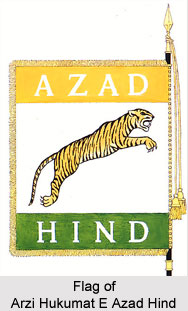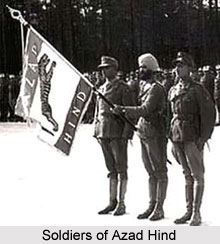 Arzi Hukumat E Azad Hind, meaning the Provisional Government of Free India, was also known as Azad Hind (Free India). It was a provisional government of India that was founded in the year 1943 in Singapore. The Arzi Hukumat E Azad Hind was among the political movement that originated during the 1940s away from India. Its objective was to gain support of the Axis powers to attain freedom for India from rule of the British Empire. Azad Hind was established by Indian nationalists who were exiled from the country during World War II. They developed the provisional government in Singapore with the political, military and monetary support from Imperial Japan in order to fight against British. Netaji Subhas Chandra Bose aimed to form the Provisional Government of Azad Hind in Germany after the carrying out the task of restructuring the Indian Independence League, initiating preparations for modernizing the army and after organising a triumphant campaign to assemble the support of the various Indian communities present in Southeast Asia.
Arzi Hukumat E Azad Hind, meaning the Provisional Government of Free India, was also known as Azad Hind (Free India). It was a provisional government of India that was founded in the year 1943 in Singapore. The Arzi Hukumat E Azad Hind was among the political movement that originated during the 1940s away from India. Its objective was to gain support of the Axis powers to attain freedom for India from rule of the British Empire. Azad Hind was established by Indian nationalists who were exiled from the country during World War II. They developed the provisional government in Singapore with the political, military and monetary support from Imperial Japan in order to fight against British. Netaji Subhas Chandra Bose aimed to form the Provisional Government of Azad Hind in Germany after the carrying out the task of restructuring the Indian Independence League, initiating preparations for modernizing the army and after organising a triumphant campaign to assemble the support of the various Indian communities present in Southeast Asia.
The Provisional Government of Free India or the Arzi Hukumat E Azad Hind was established on 21st October 1943 and was motivated by the ideologies of Subhash Chandra Bose, who acted as the Head of State of the Provisional Indian Government in Exile, as well as the leader of the government. It announced right and control over civilian and military personnel, who were from India, in Southeast Asian British colonial regions. Moreover, the government proclaimed eventual authority over Indian territory that was under the Japanese forces and the Indian National Army during the Japanese propulsion towards India during World War II.
The Arzi Hukumat E Azad Hind comprised of its own legal tender, court and civil code. The formation of this government provided a better legitimacy to the Indian freedom struggle against the British administration in India. Although the government of Azad Hind had all the supposed prerequisites of a legitimate government, it required definite regions of self-governing territory until it took control of the Andaman and Nicobar Islands in the year 1943, from Japan. The provisional government also occupied parts of Nagaland and Manipur. The Azad Hind government was greatly dependent on the support of the Japanese throughout its continuation.
After the formation of the Arzi Hukumat E Azad Hind, the government-in-exile announced war against the Anglo American allied forces on the Indo Burma Front. The Indian National Army (INA) or the Azad Hind Fauj, which was the army of the government, went to fight against the British Indian Army and the allied forces along with the Imperial Japanese Army in the sector of Imphal Kohima. The existence of Azad Hind was basically coterminous with the subsistence of the Indian National Army. The Arzi Hukumat E Azad Hind or the Provisional Government of Free India existed until the civil administration of the Andaman Islands was reassigned to the jurisdiction of the British Government during the culmination of the war. The restricted authority of Azad Hind was effectively finished with the surrender of the final major contingent of troops of Azad Hind Fauj in Rangoon. The alleged death of Subhas Chandra Bose on August 18, 1945 was considered as the end of the whole Azad Hind Movement. Thus the Arzi Hukumat E Azad Hind was disestablished on 18 August 1945.
Members of Arzi Hukumat E Azad Hind
 Netaji Subhas Chandra Bose acted as the Prime Minister, the Head of the State, and the Minister for War and Foreign Affairs of the Cabinet of the Provisional Government of Azad Hind. It also comprised of a Women`s Organization which was led by Lakshmi Sahgal (Lakshmi Swaminathan). She held the position over and above her command of the Rani Jhansi Regiment, which was a brigade of women soldiers who fought for the Azad Hind Fauj.
Netaji Subhas Chandra Bose acted as the Prime Minister, the Head of the State, and the Minister for War and Foreign Affairs of the Cabinet of the Provisional Government of Azad Hind. It also comprised of a Women`s Organization which was led by Lakshmi Sahgal (Lakshmi Swaminathan). She held the position over and above her command of the Rani Jhansi Regiment, which was a brigade of women soldiers who fought for the Azad Hind Fauj.
There were several other public administration ministers of the Arzi Hukumat E Azad Hind, including Mr. S. A. Ayer, who served as the Minister of Broadcasting and Publicity; and Lieutenant Colonel A. C. Chatterjee, who served as the Minister of Finance. The Arzi Hukumat E Azad Hind was administered by various Secretaries and Advisors to Netaji Subhas Chandra Bose, namely, A.N. Sahay (Secretary), Karim Ghani, D.M. Khan, Debnath Das, Sirdar Isher Singh, A. Yellapa, J. Thivy and A. N. Sarkar, who served as the official Legal Advisor of the provisional government. All of the Advisory officials and Secretaries held Ministerial rank in the Azad Hind.
The Armed Forces ministers of the Indian National Army or Azad Hind Fauj are mentioned as follows-
* Lieutenant Colonel Aziz Ahmed
* Lieutenant Colonel N. S. Bhagat
* Lieutenant Colonel Ehsan Qadir
* Lieutenant Colonel J. K. Bhonsle
* Lieutenant Colonel A. D. Loganathan
* Lieutenant Colonel Guizara Singh
* Lieutenant Colonel M.Z. Kiani
* Lieutenant Colonel Shah Nawaz Khan



















